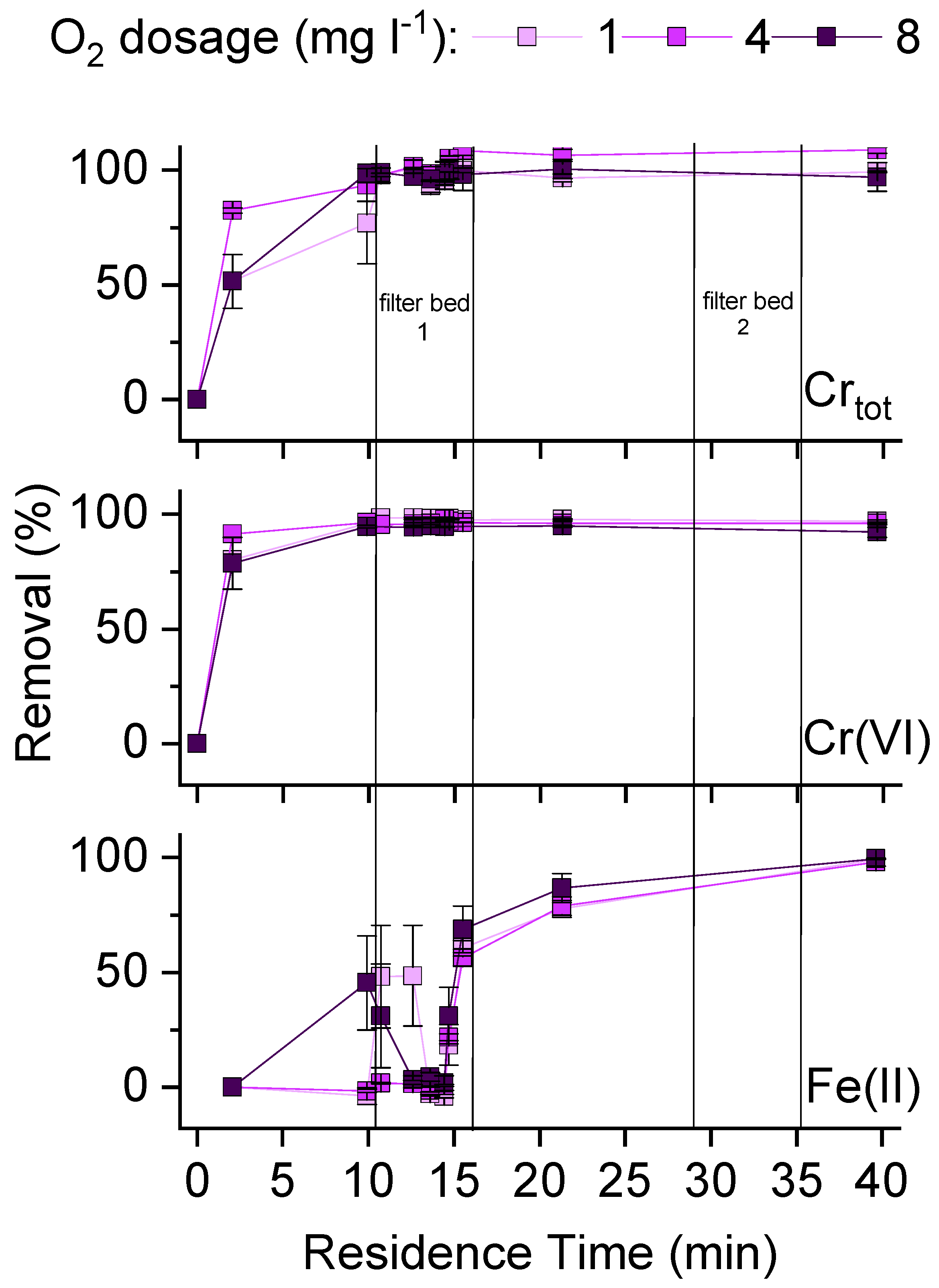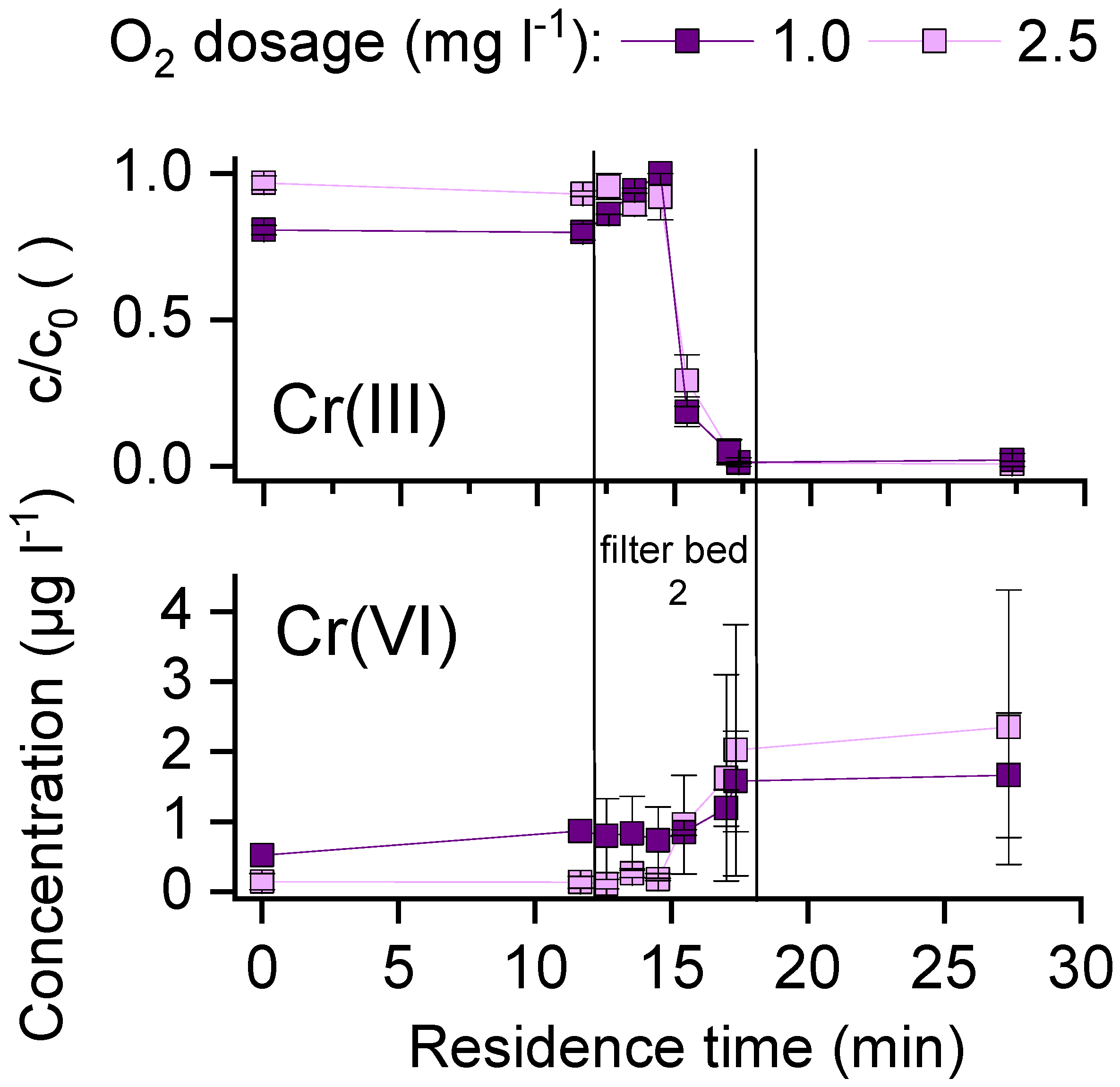Redox Behavior of Chromium in the Reduction, Coagulation, and Biotic Filtration (RCbF) Drinking Water Treatment—A Pilot Study
Abstract
:1. Introduction
2. Materials and Methods
2.1. Chemicals
2.2. Pilot Waterworks
2.3. Experimental Procedure
2.4. Analyses
3. Results
3.1. Potential Influences of Oxidizing Water Constituents
3.2. O2 or NO3− as Competing Oxidants and Potential Drivers for Re-Oxidation of Cr(III)
3.3. Oxidation of Cr(III) to Cr(VI) by O2 with MnO2 as a Mediator
3.4. Mixing of Cr(VI) Containing Water with Fe(II) Containing Groundwater
4. Conclusions
Supplementary Materials
Author Contributions
Funding
Data Availability Statement
Acknowledgments
Conflicts of Interest
Abbreviations
References
- Barnhart, J. Occurrences, Uses, and Properties of Chromium. Regul. Toxicol. Pharmacol. 1997, 26, S3–S7. [Google Scholar] [CrossRef]
- Bartlett, R.J. Chromium Cycling in Soils and Water: Links, Gaps, and Methods. Env. Health Perspect 1991, 92, 17–24. [Google Scholar] [CrossRef]
- Rai, D.; Eary, L.E.; Zachara, J.M. Environmental Chemistry of Chromium. Sci. Total Environ. 1989, 86, 15–23. [Google Scholar] [CrossRef] [PubMed]
- Rai, D.; Sass, B.M.; Moore, D.A. Chromium(III) Hydrolysis Constants and Solubility of Chromium(III) Hydroxide. Inorg. Chem. 1987, 26, 345–349. [Google Scholar] [CrossRef]
- Sass, B.M.; Rai, D. Solubility of Amorphous Chromium(III)-Iron(III) Hydroxide Solid Solutions. Inorg. Chem. 1987, 26, 2228–2232. [Google Scholar] [CrossRef]
- McCarroll, N.; Keshava, N.; Chen, J.; Akerman, G.; Kligerman, A.; Rinde, E. An Evaluation of the Mode of Action Framework for Mutagenic Carcinogens Case Study II: Chromium (VI). Environ. Mol. Mutagen. 2010, 51, 89–111. [Google Scholar] [CrossRef]
- Sedman, R.M.; Beaumont, J.; Mcdonald, T.A.; Reynolds, S.; Krowech, G.; Howd, R. Review of the Evidence Regarding the Carcinogenicity of Hexavalent Chromium in Drinking Water. J. Environ. Sci. Health 2006, 24, 155–182. [Google Scholar] [CrossRef]
- Stern, A.H. A Quantitative Assessment of the Carcinogenicity of Hexavalent Chromium by the Oral Route and Its Relevance to Human Exposure. Environ. Res. 2010, 110, 798–807. [Google Scholar] [CrossRef]
- Zhitkovich, A. Chromium in Drinking Water: Sources, Metabolism, and Cancer Risks. Chem. Res. Toxicol. 2011, 24, 1617–1629. [Google Scholar] [CrossRef]
- De Flora, S. Threshold Mechanisms and Site Specificity in Chromium(VI) Carcinogenesis. Carcinogenesis 2000, 21, 533–541. [Google Scholar] [CrossRef]
- Kopec, A.K.; Kim, S.; Forgacs, A.L.; Zacharewski, T.R.; Proctor, D.M.; Harris, M.A.; Haws, L.C.; Thompson, C.M. Genome-Wide Gene Expression Effects in B6C3F1 Mouse Intestinal Epithelia Following 7 and 90days of Exposure to Hexavalent Chromium in Drinking Water. Toxicol. Appl. Pharmacol. 2012, 259, 13–26. [Google Scholar] [CrossRef]
- Moffat, I.; Martinova, N.; Seidel, C.; Thompson, C.M. Hexavalent Chromium in Drinking Water: JOURNAL AWWA. J.—Am. Water Work. Assoc. 2018, 110, E22–E35. [Google Scholar] [CrossRef]
- Thompson, C.M.; Haws, L.C.; Harris, M.A.; Gatto, N.M.; Proctor, D.M. Application of the U.S. EPA Mode of Action Framework for Purposes of Guiding Future Research: A Case Study Involving the Oral Carcinogenicity of Hexavalent Chromium. Toxicol. Sci. 2011, 119, 20–40. [Google Scholar] [CrossRef]
- Thompson, C.M.; Kirman, C.R.; Proctor, D.M.; Haws, L.C.; Suh, M.; Hays, S.M.; Hixon, J.G.; Harris, M.A. A Chronic Oral Reference Dose for Hexavalent Chromium-Induced Intestinal Cancer: Reference Dose for Cr(VI)-Induced Intestinal Cancer. J. Appl. Toxicol. 2014, 34, 525–536. [Google Scholar] [CrossRef]
- Thompson, C.M.; Rager, J.E.; Suh, M.; Ring, C.L.; Proctor, D.M.; Haws, L.C.; Fry, R.C.; Harris, M.A. Transcriptomic Responses in the Oral Cavity of F344 Rats and B6C3F1 Mice Following Exposure to Cr(VI): Implications for Risk Assessment: Transcriptomic Responses in the Oral Cavity. Environ. Mol. Mutagen. 2016, 57, 706–716. [Google Scholar] [CrossRef]
- National Toxicology Program. Toxicology and Carcinogenesis Studies of Sodium Dichromate Dihydrate (Cas No. 7789-12-0) in F344/N Rats and B6C3F1 Mice (Drinking Water Studies). Natl. Toxicol. Program Tech. Rep. Ser. 2008, 546, 1–192. [Google Scholar]
- WHO. Chromium in Drinking-Water—Background Document for Development of WHO Guidelines for Drinking-Water Quality; World Health Organization: Geneva, Switzerland, 2020; p. 38. [Google Scholar]
- Roller, M. Potentielle Schädlichkeit von Chrom Im Trinkwasser—Einordnung Der Epidemiologischen Befunde Zum Krebsrisiko Nach Exposition von Populationen Gegenüber Chrom(VI) Im Trinkwasser Und Vorschlag Zur Ableitung Einer Expositions-Risikobeziehung; Beratungsbüro für Risikoabschätzung: Dortmund, Germany, 2012; p. 79. [Google Scholar]
- EU. Directive (EU) 2020/2184 of the European Parliament and of the Council of 16 December 2020 on the Quality of Water Intended for Human Consumption. 2020, p. 62. Available online: https://environment.ec.europa.eu/topics/water/drinking-water_en (accessed on 21 September 2023).
- BMG. German Drinking Water Ordinance. 2023. Available online: https://www.gesetze-im-internet.de/trinkwv_2023/TrinkwV.pdf (accessed on 21 September 2023).
- California Water Boards. State Water Resources Control Board Proposed Hexavalent Chromium MCL Staff Report; California Department of Public Health: Sacramento, CA, US, 2022; p. 9. [Google Scholar]
- Blute, N.; Wu, X.; Cron, C.; Abueg, R.; Froelich, D.; Fong, L. Hexavalent Chromium Treatment Implementation in Glendale, Calif. J.—Am. Water Work. Assoc. 2014, 106, E160–E175. [Google Scholar] [CrossRef]
- Allendorf, A.; Bauer, K.-H.; Huschens, O.; Post, B.; Weygand, A.; Riegel, M.; Schlitt, V.; Sacher, F. Untersuchungen Zum Vorkommen von Sechswertigem Chrom Und Seiner Entfernung Bei Der Trinkwasseraufbereitung; Deutsche Verein des Gas- und Wasserfachs: Bonn, Germany, 2016; p. 149. [Google Scholar]
- Lee, G.; Hering, J.G. Removal of Chromium(VI) from Drinking Water by Redox-Assisted Coagulation with Iron(II). J. Water Supply: Res. Technol.—Aqua 2003, 52, 319–332. [Google Scholar] [CrossRef]
- McGuire, M.J.; Blute, N.K.; Seidel, C.; Qin, G.; Fong, L. Pilot-Scale Studies of Hexavalent Chromium Removal from Drinking Water. J.—Am. Water Work. Assoc. 2006, 98, 134–143. [Google Scholar] [CrossRef]
- Sharma, S.K.; Branislav, P.; Gary, A. Chromium Removal from Water: A Review. J. Water Supply Res. Technol.-Aqua 2008, 57, 541–553. [Google Scholar] [CrossRef]
- Mahringer, D.; Zerelli, S.S.; Dippon, U.; Ruhl, A.S. Pilot Scale Hexavalent Chromium Removal with Reduction, Coagulation, Filtration and Biological Iron Oxidation. Sep. Purif. Technol. 2020, 253, 117478. [Google Scholar] [CrossRef]
- DVGW. Enteisenung Und Entmanganung—Teil 1: Grundsätze Und Verfahren; Deutsche Verein des Gas- und Wasserfachs: Bonn, Germany, 2005; p. 34. [Google Scholar]
- Mahringer, D.; Zerelli, S.S.; Ruhl, A.S. Pilot-Scale Vanadium Adsorption onto in-Situ Biogenic Amorphous Ferric Hydroxide. J. Water Process Eng. 2023, 56, 104278. [Google Scholar] [CrossRef]
- Mahringer, D.; Polenz, C.; El-Athman, F. Stabilization of Chromium (VI) in the Presence of Iron (II): Method Development and Validation. Water 2020, 12, 924. [Google Scholar] [CrossRef]
- Huber, S.A.; Balz, A.; Abert, M.; Pronk, W. Characterisation of Aquatic Humic and Non-Humic Matter with Size-Exclusion Chromatography—Organic Carbon Detection—Organic Nitrogen Detection (LC-OCD-OND). Water Res. 2011, 45, 879–885. [Google Scholar] [CrossRef]
- Kotaś, J.; Stasicka, Z. Chromium Occurrence in the Environment and Methods of Its Speciation. Environ. Pollut. 2000, 107, 263–283. [Google Scholar] [CrossRef] [PubMed]
- Sigg, L.; Stumm, W. Aquatische Chemie: Einführung in Die Chemie Natürlicher Gewässer, 6th ed.; UTB Naturwissenschaften, Umweltwissenschaften; 6., vollst. überarb. Aufl.; vdf Hochschul-Verl: Zürich, Switzerland, 2016; ISBN 978-3-7281-3768-5. [Google Scholar]
- Millero, F.J. The Effect of Ionic Interactions on the Oxidation of Metals in Natural Waters. Geochim. Et Cosmochim. Acta 1985, 49, 547–553. [Google Scholar] [CrossRef]
- Morgan, B.; Lahav, O. The Effect of PH on the Kinetics of Spontaneous Fe(II) Oxidation by O2 in Aqueous Solution—Basic Principles and a Simple Heuristic Description. Chemosphere 2007, 68, 2080–2084. [Google Scholar] [CrossRef]
- Grothe, P.; Czekalla, C. Enteisenung und Entmanganung. In Wasseraufbereitung—Grundlagen und Verfahren; Gimbel, R., Jekel, M., Deutsche Vereinigung des Gas- und Wasserfaches, Eds.; Lehr- und Handbuch Wasserversorgung; Oldenbourg Industrieverl: München, Germany, 2004; ISBN 978-3-486-26365-7. [Google Scholar]
- Buerge, I.J.; Hug, S.J. Kinetics and PH Dependence of Chromium (VI) Reduction by Iron (II). Environ. Sci. Technol. 1997, 31, 1426–1432. [Google Scholar] [CrossRef]
- Eary, L.E.; Rai, D. Chromate Removal from Aqueous Wastes by Reduction with Ferrous Ion. Environ. Sci. Technol. 1988, 22, 972–977. [Google Scholar] [CrossRef]
- BGR. SGD WMS Information Der BGR Hannover: Hydrogeologische Karte von Deutschland 1:200.000, Hintergrundwerte (HÜK200 HGW); Thema Hydrogeochemie, Hintergrundwerte Im Grundwasser; BGR: Hannover, Germany, 2014. [Google Scholar]
- van Berk, W.; Fu, Y. Redox Roll-Front Mobilization of Geogenic Uranium by Nitrate Input into Aquifers: Risks for Groundwater Resources. Environ. Sci. Technol. 2017, 51, 337–345. [Google Scholar] [CrossRef]
- Rai, D.; Moore, D.A.; Hess, N.J.; Rosso, K.M.; Rao, L.; Heald, S.M. Chromium (III) Hydroxide Solubility in the Aqueous K+-H+-OH−-CO2-HCO3−-CO32−-H2O System: A Thermodynamic Model. J. Solut. Chem. 2007, 36, 1261–1285. [Google Scholar] [CrossRef]





Disclaimer/Publisher’s Note: The statements, opinions and data contained in all publications are solely those of the individual author(s) and contributor(s) and not of MDPI and/or the editor(s). MDPI and/or the editor(s) disclaim responsibility for any injury to people or property resulting from any ideas, methods, instructions or products referred to in the content. |
© 2023 by the authors. Licensee MDPI, Basel, Switzerland. This article is an open access article distributed under the terms and conditions of the Creative Commons Attribution (CC BY) license (https://creativecommons.org/licenses/by/4.0/).
Share and Cite
Mahringer, D.; Zerelli, S.S.; Ruhl, A.S. Redox Behavior of Chromium in the Reduction, Coagulation, and Biotic Filtration (RCbF) Drinking Water Treatment—A Pilot Study. Water 2023, 15, 3363. https://doi.org/10.3390/w15193363
Mahringer D, Zerelli SS, Ruhl AS. Redox Behavior of Chromium in the Reduction, Coagulation, and Biotic Filtration (RCbF) Drinking Water Treatment—A Pilot Study. Water. 2023; 15(19):3363. https://doi.org/10.3390/w15193363
Chicago/Turabian StyleMahringer, Daniel, Sami S. Zerelli, and Aki S. Ruhl. 2023. "Redox Behavior of Chromium in the Reduction, Coagulation, and Biotic Filtration (RCbF) Drinking Water Treatment—A Pilot Study" Water 15, no. 19: 3363. https://doi.org/10.3390/w15193363
APA StyleMahringer, D., Zerelli, S. S., & Ruhl, A. S. (2023). Redox Behavior of Chromium in the Reduction, Coagulation, and Biotic Filtration (RCbF) Drinking Water Treatment—A Pilot Study. Water, 15(19), 3363. https://doi.org/10.3390/w15193363








